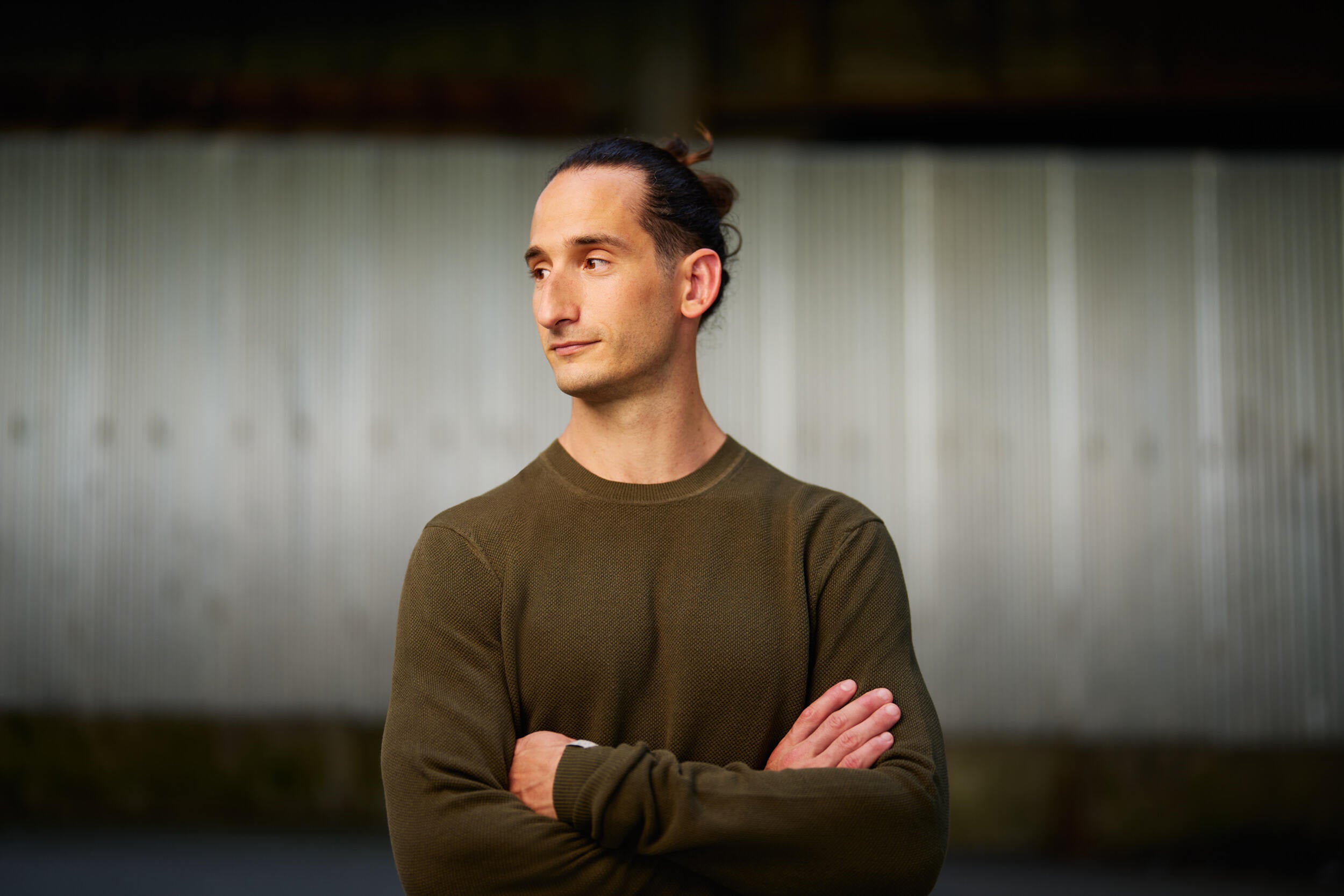TRAINED FOR THE GAMES: This Elite CrossFitter Designs EPIC Programs

TRAINED FOR THE GAMES is a four-part interview series that explores the training, nutrition, and recovery of four elite-level athletes that participated in Spartan Games 2.0, presented by U.S. Air Force Special Warfare. Episode 1 will premiere on March 24 at 8 p.m. ET. You can watch on Outside TV, SpartanTV, and Spartan's YouTube channel.
Christian Harris is big, strong, fast, and athletic. It's no wonder that he received an invite to Spartan Games 2.0, and undoubtedly put on a show. The 35-year-old former all-conference wide receiver turned elite CrossFitter, coach, and owner/creator of MFLH has spent decades fine-tuning his training, nutrition, and recovery, and continuously puts it all to the test. This dedication and commitment to his craft has led to appearances at the CrossFit Games and a unique ability to create some of the most innovative training programs in the world.
Here, the elite CrossFitter shares how he first discovered fitness and why DEKA Heavy and the Titan Fitness Husacross from Spartan Games 2.0 were right in his wheelhouse, plus he provides a glimpse at his performance eating plan, recovery must-dos, and more.
A Q&A With Spartan Games 2.0 Athlete Christian Harris

SPARTAN: How did you get into CrossFit?
CHRISTIAN HARRIS: I’ve been an athlete my entire life, so fitness has always been a part of that. I picked up football my senior year of high school and did pretty well. I was originally a baseball player, but a couple of the guys that I sat with at lunch were like, "Why don't you try football?" So I gave it a shot, and ended up pursuing it in college.
My senior year of college, I was an all-conference wide receiver, and while I did have some talent, I was one of those guys that always worked hard and had to work for it. I always wanted to be the best that I could be, so I always pushed myself in the weight room and off-season conditioning. Once football was done, I needed something to fulfill my competitiveness, so one of my buddies told me about CrossFit. I gave a workout a shot, it kicked my ass, and I realized I needed more of it. From there, I dove headfirst, got certified, and started working out at a CrossFit box. I started coaching, and then immediately got into the competitive side of it. It’s been 10 years now and here we are.
SPARTAN: What was the Spartan Games experience like for you?
CH: It was very challenging, but I loved it and embraced it. The style of the events were completely out of my comfort zone I'd say, with the exception of maybe the first one, DEKA Heavy. I was middle of the pack in that. Let’s just say there was a good lane and a bad lane with the sleds. And I’m not making any excuses or anything like that, but it was rainy that day and I was definitely being challenged on that bad side.
Related: TRAINED FOR THE GAMES: This 'Scrawny Runner' Is Now an Elite Athlete
SPARTAN: Speaking of challenges, what are your thoughts on the Titan Husacross?
CH: I like that. That's my jam. I do a lot of sandbag training and sandbag carries, so it wasn't really anything new for me. It's very similar in concept. You definitely want to do some sandbag work for that. I’m talking bear hug carries, bear hug squats, things of that nature.

SPARTAN: Is there anything you would have done differently to prepare?
CH: I would've run a lot more. Maybe if I had a few months, I probably would have incorporated some sort of marathon-prep type stuff, because running was a big component of the majority of the workouts. And I'm not going to say [I’m a] weak runner because in my world I'm an okay runner, but these athletes are just on a whole other level when it comes to the endurance that they're able to sustain over such long periods.
SPARTAN: How would you describe your approach to food and nutrition?
CH: My philosophy has changed a bit over the past couple of years, especially as I'm getting older. I'm looking to do things that are going to help with longevity. So, one of the things that I'm very conscious of is the quality of the foods that I'm putting into my body. I try to stay away from things like sugar. I also try to stay away from dairy just because it's highly inflammatory. And, over the past two-ish years, I’ve been doing a lot of intermittent fasting because I’ve been reading up on a lot of the benefits that it has from a healing standpoint. I pretty much do that on a daily basis, and will hit at least 16 hours of fasting.
SPARTAN: When do you do the 16 hours?
CH: I do it from about 7 or 8 p.m. and then I eat at 11 a.m. or noon. I work out in the morning, so I'm usually doing my training fasted, however, that's going to change now that I'm getting into seasonal training twice a day. I'm going to definitely want to make sure I'm fueling myself in between the sessions to maximize recovery, but also to have the energy to sustain throughout the sessions.
Related: TRAINED FOR THE GAMES: This Airman Took on the Titans of Fitness
SPARTAN: What do your meals look like?
CH: I’m a creature of habit. Overnight oats are one of my staple go-to meals on a weekly basis. I'll have that after my fasted cardio session. Then, once I get into the heavy lifting and the high-intensity work, I'll follow that up with a proper meal with a lot of carbs, like white rice or sweet potatoes or something like that to refuel after that session. It's pretty low on protein and pretty low on fat at that point.
My next two meals throughout the day would be pretty balanced between my macros of protein, fats, and carbs. I also follow a nutrition methodology called RP Strength. I've been working with them since 2016, and they've given me the tools to understand macronutrients and meal timing around your workouts and understanding the importance of getting your carbs in around your workout times. It helps to fuel your performance and your recovery.

SPARTAN: How about your recovery protocol, what does that look like?
CH: In terms of recovery, I need to do a better job of seeing body work. I had been doing it with a bit more frequency when I first got into CrossFit. I was going probably weekly, whereas now I go maybe five or six times a year. I like to call it a quarterly tuneup. But, I do have some recovery protocols that I go through post-workout.
I like to do some myofascial release with either lacrosse balls or foam rollers. I definitely like to stretch, so I'll spend about 20 to 30 minutes after my session doing that. I do also have an infrared sauna, which I'll spend time in at least once a week when I have the time for it. And, I have my WHOOP, which tracks all of the metrics I need to keep an eye on.
SPARTAN: What has been one of the most important things you’ve learned as an athlete over the years?
CH: Mindset is something that I've had the opportunity to see myself grow in quite a bit. I try to work on positive self-talk before workouts, along with a lot of visualization stuff. Before a workout, I’m visualizing some sort of success, even visualizing things that might not go my way, and how I might say, "All right. What's my backup plan?" So, just having all of these things in place, as best as I can so that when I do get punched in the mouth, I have a backup plan.
Related: TRAINED FOR THE GAMES: How This Elite CrossFitter Evolves as an Athlete
SPARTAN: What’s next for you?
CH: I think it's really just the constant pursuit of betterment in any aspect or facet of life that I put myself in. Sports and fitness is something that resonated with me from a young age, and I'm very passionate about it. But I'm also an entrepreneur, so in those businesses that I'm a part of, I try to apply the things that I've learned in my fitness life in terms of hard work and being resilient when things get tough and challenging. I try to apply that to my entrepreneurial pursuits as well.

SPARTAN: What's one of your go-to Spartan workouts?
20-minute AMRAP:
— 10-calorie row
— 50-foot farmer's carry
— 20-calorie row
— 100-foot farmer's carry
— 30-calorie row
— 150-foot farmer's carry
... and so on, until time expires. And every 4 minutes, do 10 burpees.
Train Like Christian Harris for a Week

Harris’ weekly training is exactly what you’d expect to see in an elite-level CrossFitter. Every angle is covered so that he’s ready to perform well in any situation. What you’ll find below is Olympic lifting, interval training, density training, skill-based training, active recovery, mobility, and even some classic bodybuilding worked in.
Monday:
AM: 30 minutes of mixed modality work that includes machines, dumbbells, and intervals. He’ll conclude with accessory work that emphasizes strengthening the posterior chain.
PM: Olympic weight lifting, which typically includes front squats and cleans followed by conditioning work with a lower-body emphasis, plus gymnastics. He’ll then perform single-leg unilateral accessory work to finish.
Tuesday:
AM: Rowing intervals
PM: Skill-based EMOM (every minute on the minute) that typically involves snatches followed by conditioning work with a focus on the upper body, including machines and carries.
Related: How to Build an At-Home Gym Like These 4 Elite Spartan Games Athletes
Wednesday:
AM: Fan bike intervals
PM: Back squats followed by repeat metcons such as 12 minutes of work, rest, and then another 12 minutes of work. The session will end with accessory exercises for the shoulders.
Thursday:
Thursday is dedicated to active recovery, which includes 30 to 40 minutes of zone 2 conditioning along with mobility and stretching.
Friday:
AM: Skill-based EMOM (every minute on the minute)
PM: Barbell capacity work; 4 sets of touch and go cleans followed by work-rest intervals of rowing, wall balls, and strict handstand push-ups. He concludes with lower-body prehab/rehab movements.
Saturday:
AM/PM: A big “Power Hour” workout followed by classic bodybuilding.
Sunday:
AM/PM: An easy zone 2 run
U.S. Air Force Special Warfare takes mental and physical toughness to the next level, which is why they were the perfect partner for this year’s Spartan Games. To learn more about the heroes who make up the top 1% of the 1%, click here.


